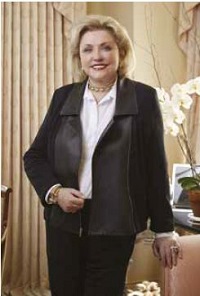Jewellery Special - Luxury Investment Index Q2 2017
Jewellery overtakes cars as wine powers ahead.
Records tumble as jewellery maintains its robust performance in the Knight Frank Luxury Investment Index
It’s all change at the top of the Knight Frank Luxury Investment Index (KFLII). Classic cars, which have dominated the rankings for the past few years, have now slipped back into sixth place on an annual basis with average prices rising by just 2% to Q2 2017.

Andrew Shirley - The Wealth Report Editor
Wine, driven by strong growth in the key Bordeaux, Burgundy and northern Italian investment-grade markets, has now claimed top spot with the year-onyear value of the Knight Frank Fine Wine Icons Index shooting up 25%.
That’s not to say the most collectable cars aren’t fetching a lot of money. Nine cars broke the $5m barrier at the recent benchmark sales in Monterey, California, with Bonhams setting a record for a Mclaren F1 ($15.6m) and RM Sotheby’s historic Aston Martin DBR1 going under the hammer for an eye-watering $22.5m.
It has also been a record-breaking year in the world of jewellery. In June, the 18.04 carat “Rockefeller” emerald set a new world record per carat for the green gem ($305,000) when it went under the hammer for $5.5m with Christie’s in New York.
In April the Pink Star, a 59.6 carat fancy vivid pink diamond, snatched the record of world’s most expensive piece of jewellery from the Oppenheimer Blue – a 14.62 carat vivid blue – when it sold for $71.2m in Hong Kong.
Interestingly, however, blue diamonds are still setting the pace in the wider market. According to data from the Fancy Color Research Foundation (FCRF), the average price of blue stones rose by 5.5% over the 12 months to June, compared with a slight drop in the value of pink diamonds.
At the top of the coloured diamond market, slight changes in colour can have a huge impact on prices. A one-carat fancy vivid blue stone, for example, would be worth roughly 10 times more than a onecarat fancy light blue stone, says FCRF.
As stones get larger the differential increases dramatically, says Eden Rachminov, chairman of the FCRF.
Jean Ghika, head of Bonhams’ London jewellery team, says great care is needed when buying coloured diamonds. “It is a very complex market. Not only are there considerable differences in pricing depending on the intensity of colour, but the addition of a secondary colour within the stone can also impact the value. It is vital to see a certificate, which should be issued from an internationally recognised laboratory stating both colour and clarity,” says Ms Ghika.
Artist jewellery
Meanwhile, the wider jewellery market continues to see steady price growth with prices up 4% over the past 12 months, according to data from Art Market Research. This headline figure, however, masks a wide differential in the performance of jewellery from varying eras and styles.
Pearls, which had seen a surge in values over the past few years, have levelled out and it is more modern jewellery that is now setting the pace.
“There is a current trend for jewels from the post-war era, where the emphasis is on design, quality and workmanship. These pieces, often unique or in limited supply, are easy to wear, distinctive and increasingly sought after by discerning collectors,” Ms Ghika explains.
In particular, pieces designed by artists (see page 4 for some of the most collectable), rather than established jewellery brands, are in high demand, she notes. “Historically, jewellery has been a form of wearable adornment, but it is now increasingly being considered an art form in its own right. Modern and contemporary jewellery designers appeal to collectors who wish to build a collection of jewellery as they might build a collection of contemporary art.”
An asset of substance
Andrew Shirley talks to one of the world’s best-selling novelists and a leading expert about their passion for jewellery

Barbara Taylor Bradford OBE
Andrew Shirley What sparked your love of jewellery?
Barbara Taylor Bradford The men in my life! My father loved jewellery and taught me to love it, too. When I was working at the Yorkshire Post he gave me a string of pearls for my eighteenth birthday. Oddly enough, I’ve also just found a little gold bracelet with my star sign on that he gave me when I was 20. My husband Bob (television producer Robert Bradford) also loves to buy me jewellery.
Susan Abeles My first job out of school was an assistant bookkeeper in an auction house. The exposure was expansive, and I quickly moved departments and learned about the business and objects. Quite by accident I was directed to the jewellery department, where my education in chemistry was reignited and my passion and interest for gemstones grew.
AS Who are your current favourite jewellery designers and why?
SA There are so many current talented jewellery designers to pick from it hardly seems fair. Today, my favourite designer is James de Givenchy for Taffin. I adore his work; he is enormously creative and adept at capturing the natural beauty of a gemstone and pairing it with a modern mounting that showcases the qualities of the gemstone which he finds important.
His work is bold and sculptural, colourful and playful and I liken this to wearable art. Tomorrow, I may be drawn to the works of designer Wallace Chan, and the day after, those masterful pieces by Daniel Brush.
BTB I’m rather impressed by a company called Verdura, which produces pieces based on the archive of Duke Fulco di Verdura who started designing for Coco Chanel. The pieces are very unusual and the workmanship is very good. The first piece Bob bought me was the Chanel bracelet, which is made of white enamel with a centrepiece of coloured jewels. I also like the designs of Suzanne Belperron. Bob bought me a beautiful strand of green beads. A designer called Dvora has also designed some really beautiful things for me.
AS What advice would you give somebody looking to start a jewellery collection?
SA In order to amass a collection of jewellery, you must acquire knowledge of the subject. To begin, I would suggest taking classes, visiting museums, going to jewellery previews at auction houses and chatting to the experts. Pick a theme for the collection that you find attractive, such as gemstones, era, designer, origin, or provenance. Watch the market to see how your theme is performing, and join collector groups. Choose your items carefully, so that each purchase counts, and remember that quality and condition count.
BTB Don’t go for lots of bits and pieces, save up your money and go for one big piece by a big name like Cartier, Tiffany or Harry Winston that will keep its value. And don’t throw away the box it came in – a friend’s husband threw away all her boxes recently – if you ever re-sell having a piece in its original box can help retain some of its value.
AS Can jewellery be a good investment?
BTB Extremely – having sold some of my pieces at auction I have the proof.
SA Historically, jewellery has been a common way to store and transfer wealth in many cultures. People will always buy jewellery. Think about it: you can put jewellery in virtually in any market, allowing for slightly different tastes. It is one the most widely collected assets on a global level, along with art, watches and wine. And it is performing extremely well. Saying all this, my advice is buy what you love and feel passionate about. If you love a piece of jewellery, you will keep it; if you keep it, you will wear it.
AS In your own experience, do tastes in jewellery change and what is hot at the moment?
SA Yes. For instance, the interest in Belle Époque and Art Nouveau jewellery has been replaced by the more wearable and collectible jewellery of the 1960s and 1970s. Jewellery from the 1980s is finding favour too, as is art jewellery.
BTB In the late 80s and 90s really big brooches were in fashion, but that seems to have died down. What people seem to be buying today are unusual or long dangling earrings and lots of bracelets that you can stack together.
AS What is your most cherished piece of jewellery and is there a particular piece you’d really like to own?
BTB A sapphire and diamond ring by Claire Richter that is like the one Prince William gave to Kate, but Bob bought mine for me 38 years ago!
SA Every day I wear a Cartier gold ring designed by Dinh Van. It has no gemstones, but I love it because of the design – strong and bold – and because it was my mother’s. I would love to have owned Anna Thompson Dodge’s five strand natural pearl necklace by Cartier, purchased in 1920 (alleged to have once been owned by Catherine the Great).
AS White or coloured diamonds? Sapphire, ruby or emerald?
SA In the ideal world, if I was able to collect any gemstone at the finest quality, my top choice would be a crystal, pigeon’s blood red, unheated, gem quality cushion-shaped ruby with exceptional saturation and liveliness. This gem need not be more than seven carats, because I would intend to wear it every day.
BTB I like white diamonds, but I love sapphires, emeralds and aquamarines. I think those are the colours that look best on blonde Englishwomen! However, it’s pearls that are my signature; if I do an event and I’m not wearing them my fans will ask: where are the pearls?
AS In your opinion, why buy jewellery not art, cars or wine?
BTB I do get a lot of pleasure looking at impressionist art, but I can throw all my jewellery in a bag and run! Being an imaginative novelist and journalist with some knowledge of the world I am always imagining what could happen.
SA Jewellery is portable and wearable; it lasts beyond wine, and does not require a garage to be housed in, nor does it sit on the wall waiting to be admired. Jewellery travels with you; it enhances and brings enchantment.
Courtesy: Knight Frank

CONTACT DETAILS FOR FURTHER INFORMATION:
Research
Andrew Shirley - The Wealth Report Editor
+44 1234 720534
Media & PR
Celia Welham
+44 20 7861 1033
Contacts and acknowledgements
HAGI www.historicautogroup.com; Stanley Gibbons www.stanleygibbons.com; Wine Owners www.artmarketresearch.com; Fancy Color Research Foundation: www.fcresearch.org; AMR www.artmarketresearch.com. AMR tracks the price movements of art, sculpture, prints and photographs as well as antiques and collectibles such as silver, porcelain, carpets clocks and more.
Knight Frank Research provides strategic advice, consultancy services and forecasting to a wide range of clients worldwide including developers, investors, funding organisations, corporate institutions and the public sector. All our clients recognise the need for expert independent advice customised to their specific needs. [email protected]
© Knight Frank LLP 2017
This report is published for general information only and not to be relied upon in any way. Although high standards have been used in the preparation of the information, analysis, views and projections presented in this report, no responsibility or liability whatsoever can be accepted by Knight Frank LLP for any loss or damage resultant from any use of, reliance on or reference to the contents of this document. As a general report, this material does not necessarily represent the view of Knight Frank LLP in relation to particular properties or projects. Reproduction of this report in whole or in part is not allowed without prior written approval of Knight Frank LLP to the form and content within which it appears. Knight Frank LLP is a limited liability partnership registered in England with registered number OC305934. Our registered office is 55 Baker Street, London, W1U 8AN, where you may look at a list of members’ names.






